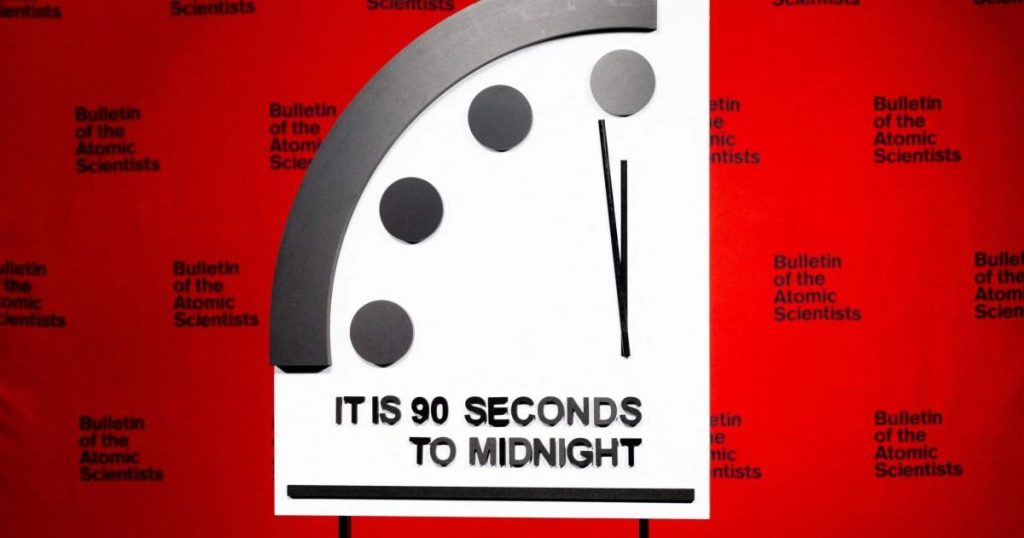The Doomsday Clock: A Ticking Reminder of Global Peril
The Doomsday Clock, a symbolic representation of humanity’s proximity to self-annihilation, serves as a stark reminder of the existential threats facing our planet. Conceived in 1947 by the Bulletin of the Atomic Scientists, this metaphorical timepiece reflects the collective assessment of leading experts on the dangers posed by nuclear weapons, climate change, bioterrorism, and disruptive technologies. The clock’s minute hand, initially set at seven minutes to midnight, has fluctuated over the years, reflecting the ebb and flow of global tensions. Currently, the clock stands at a precarious 90 seconds to midnight, the closest it has ever been to the symbolic hour of global catastrophe.
Each year, the Bulletin of the Atomic Scientists convenes a panel of experts, including Nobel laureates, to deliberate on the current state of global affairs and adjust the clock accordingly. The evaluation process hinges on two fundamental questions: Is humanity safer or at greater risk this year compared to the previous year? And is humanity safer or at greater risk this year compared to the past 75 years? These questions encapsulate the urgency and gravity of the challenges facing humankind, demanding a comprehensive assessment of both immediate and long-term threats.
The year 2024 presented a complex tapestry of global events, marked by both hopeful signs and alarming developments. While the cessation of hostilities between Israel and Hamas offered a glimmer of hope, the ongoing conflict in Ukraine continued to cast a long shadow over international security. The potential for escalation remained a constant concern, particularly given Russia’s veiled threats of nuclear weapon deployment. Furthermore, the looming expiration of the Treaty on the Non-Proliferation of Nuclear Weapons in 2026 added another layer of complexity to the global nuclear landscape.
The specter of climate change continued to loom large in 2024, with extreme weather events and rising global temperatures serving as stark reminders of the urgency of the crisis. While the Biden administration’s re-entry into the Paris Climate Agreement signaled a renewed commitment to international cooperation, the resurgence of climate-skeptic rhetoric and policies under the Trump administration raised concerns about the future of climate action. The stark contrast between these two approaches underscores the fragility of international agreements and the ongoing political battles surrounding climate change.
The Doomsday Clock’s potential movement in 2025 hinges on a multitude of factors. The ongoing war in Ukraine and the possibility of nuclear escalation remain paramount concerns. The future of international arms control treaties, particularly the Non-Proliferation Treaty, will play a critical role in determining the trajectory of global security. Moreover, the global response to climate change, including the implementation of the Paris Agreement and the development of sustainable energy technologies, will significantly impact the long-term prospects for human survival.
Beyond these immediate concerns, the Bulletin of the Atomic Scientists also considers emerging threats, such as bioterrorism and the potential misuse of artificial intelligence. The rapid advancement of biotechnology presents both opportunities and risks, demanding careful regulation and international cooperation to prevent the accidental or intentional release of dangerous pathogens. Similarly, the increasing sophistication of artificial intelligence raises concerns about autonomous weapons systems and the potential for algorithmic bias to exacerbate existing inequalities.
In evaluating the overall trajectory of global security, the Bulletin of the Atomic Scientists considers not only the magnitude of individual threats but also their interconnectedness. The confluence of nuclear proliferation, climate change, and technological disruption creates a complex web of risks that demand a holistic and integrated approach. The Doomsday Clock, therefore, serves not only as a warning of impending danger but also as a call for international cooperation and collective action to address the existential challenges facing humanity.
The announcement of the Doomsday Clock’s new setting in 2025 will provide a critical assessment of the current state of global affairs. Whether the clock moves closer to midnight, remains static, or recedes slightly, the symbolic timepiece serves as a potent reminder of the fragility of our existence and the urgent need for global cooperation to mitigate the risks we face. The Doomsday Clock is not merely a measure of time; it is a reflection of our collective choices and a call to action to safeguard the future of humanity.




